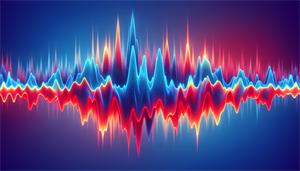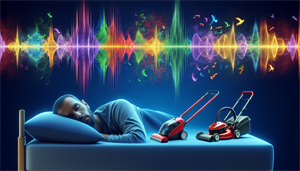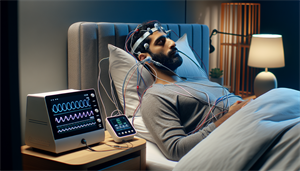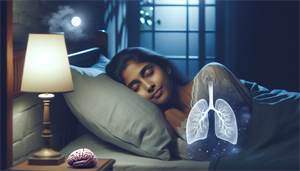Have you ever been nudged awake by the thunderous sound of snoring? Or perhaps you are the symphony conductor of the night? Understanding snoring, its intensity and implications is crucial for both snorers and their partners. With snoring affecting many adults worldwide, it is essential to grasp its intricacies, such as how many decibels is snoring, to ensure a better night’s rest and a healthier life.
Key Takeaways
-
Snoring can range from 60-80 decibels in volume, with the loudest recorded snoring reaching 111.6 decibels.
-
Factors such as age, weight, lifestyle habits and alcohol consumption affect the intensity of snoring and may necessitate Medical evaluation or treatment options.
-
Earplugs and white noise machines are effective strategies to reduce disruption caused by a snoring partner.
Snoring Decibel Levels

Snoring is not just an annoying nocturnal symphony; it is a symphony with varying volumes and intensities. The decibel levels of snoring range significantly, similar to the variance in music genres from a soothing lullaby to a heavy metal concert. The typical decibel range for snoring falls between 60 and 80 decibels, with the loudest snoring recorded at a staggering 111.6 decibels, exceeding the noise of a vacuum cleaner!
Snoring is a sonic manifestation of the vibration of pharyngeal tissues, caused by turbulent airflow through a narrow oropharynx. However, the intensity of snoring does not necessarily indicate the severity of obstruction in the upper airway. Factors such as:
-
body mass index
-
neck size
-
sleep stage
-
body position
Several factors have been recognized to impact snoring severity.
Mild Snoring
Mild snoring, typically around 40 decibels, is the quiet murmur in the concert of sleep sounds. It is generally not disruptive enough to cause significant sleep disturbances for the snorer or their partner. But, even these hushed tones can affect sleep quality, resulting in daytime sleepiness, mood swings, and difficulties in concentration.
Mild snoring can sometimes signal more than just a minor annoyance. It may be a sign of obstructive sleep apnea (OSA), which can pave the way for serious health issues like cardiovascular disease and high blood pressure. Hence, it’s crucial not to overlook even mild snoring, as it might necessitate a sleep study for a proper diagnosis.
Moderate Snoring
Moderate snoring, reaching decibel levels between 50 and 70 dB, is the rock music of the night - louder, more disruptive, and potentially indicative of underlying health issues. This level of snoring can disrupt sleep patterns and increase the risk of complications such as daytime sleepiness and moodiness, especially if associated with obstructive sleep apnea.
Factors associated with moderate snoring include conditions such as obesity, alcohol consumption, sedative medications, chronic nasal congestion, and enlarged anatomical structures such as tonsils, tongue, or a soft palate. One should stay alert for symptoms like perceptible vibrations, and noises including whistling, grumbling, snorting, and rumbling during sleep, as these could signal a need for medical attention.
Severe Snoring
Severe snoring is the heavy metal of snoring sounds, reaching decibels over 60. This level of snoring can be as loud as a vacuum cleaner or even a lawn mower. Severe snoring is frequently linked to obstructive sleep apnea (OSA), a sleep disorder that involves the partial or complete blockage of the upper airway during sleep. However, the intensity of snoring does not always correspond to the severity of sleep apnea.
The health implications of severe snoring are significant. It can lead to:
-
Disruptions to sleep quality
-
Gasping, choking, and interrupted breathing during sleep
-
Increased daytime sleepiness
-
Higher risk of injury
-
Elevated risk of stroke, heart attack, diabetes, obesity, hypertension, heart disease, higher blood pressure, and potential heart enlargement.
Factors Affecting Snoring Intensity
Age, weight, and lifestyle habits play a significant role in the soundtrack of our sleep. As individuals advance in age, there is a tendency for the intensity of snoring to increase. This may be due to anatomical changes in the throat and airway, which can lead to breathing pauses and an increased risk of sleep apnea.
Being overweight, alcohol consumption, and sleep apnea are factors that contribute to noisy snoring and disordered sleep breathing. There’s a strong correlation between body weight and the intensity of snoring. Research indicates that snoring is more prevalent in individuals who are overweight or obese. Furthermore, abdominal obesity has been found to have a significant association with snoring.
Age
As we age, the probability of snoring tends to rise, becoming more pronounced after the age of 30. This increase is due to anatomical changes in the throat that contribute to snoring. The changes include:
-
Weakening and sagging of the tongue and muscles around the airway, which can obstruct sleep-time breathing
-
Changes in muscle tone elasticity
-
Increase in the size of the uvula
-
Sagging of the roof of the mouth tissue
All of these changes contribute to snoring.
Middle-aged individuals, particularly those over the age of 30, are at a higher risk of developing snoring issues and sleep apnea syndrome. Continuous positive airway pressure (CPAP) therapy may be recommended for some individuals to alleviate snoring and sleep apnea symptoms.
Weight
The relationship between weight and snoring is noteworthy. Excess weight or obesity can result in an increased amount of soft tissue in the mouth and throat, elevating the likelihood of snoring. The accumulation of fat in the neck area can also obstruct the airway during sleep, leading to snoring and potential sleep apnea.
Excess weight can impact the respiratory system by inducing volume loss and a decrease in lung compliance, leading to a reduction in airway size and tone. Moreover, excess weight can lead to the accumulation of fat deposits in the neck, potentially obstructing the upper airway during sleep and contributing to sleep disordered breathing.[2.2_2]]
Lifestyle Habits
Lifestyle habits exert an influence on snoring by contributing to the constriction of the airway. Behaviors such as obesity, smoking, and alcohol consumption can induce relaxation of the throat muscles and the accumulation of fatty tissue in the throat. These alterations impede the airway, leading to more frequent and louder snoring, and sleep disordered breathing.[2.3_1]]
Specific sleeping positions, particularly on the back, can exacerbate snoring by allowing the tongue and soft tissues to retract into the throat, further constricting the airway. Hence, making changes to our lifestyle can significantly help in minimizing snoring.
How Snoring Decibels Compare to Other Sounds

Comparing the decibel levels of snoring to everyday sounds can provide a better understanding of its magnitude. Snoring can be as loud as:
-
a vacuum cleaner at 70 dB
-
a lawn mower at 90 dB Other prevalent sounds that resonate at similar noise levels to an average snoring session include:
-
honking cars
-
barking dogs
-
palatal flutter.
This comparison gives us a tangible understanding of the noise levels associated with snoring.
Health Risks Associated with Loud Snoring

Loud snoring may indicate sleep apnea, a potentially dangerous disorder in which breathing repeatedly stops during sleep. The most prevalent indication of sleep apnea is loud snoring, accompanied by breathing pauses and gasping for breath.
Indeed, a notable positive correlation exists between the severity of occlusive sleep apnea, also known as obstructive sleep apnea, and the snoring intensity correlate, indicating that louder snoring is frequently linked to more severe sleep apnea. However, the intensity of snoring does not always correspond to the severity of sleep apnea.
Severe snoring can result in disruptions to sleep quality, gasping, choking, and interrupted breathing during sleep.
Diagnosing and Treating Snoring Issues

When snoring becomes excessively loud, it’s an indication to seek professional medical attention. A sleep study, also referred to as polysomnography, is a diagnostic test utilized for identifying sleep disorders, including snoring issues. Throughout the study, an array of bodily functions such as brain waves, breathing patterns, and heart rate are observed and documented while the individual is asleep.
The treatment for snoring issues can vary depending on the severity and underlying causes. Some possible treatments include:
-
Lifestyle changes
-
Oral appliances
-
Positive airway pressure (PAP) therapy
-
Somnoplasty
-
Tonsillectomy and adenoidectomy
-
Behavioral adjustments such as sleeping on the side, using nasal strips, and raising the head of the bed.
It is important to consult with a healthcare professional to determine the best treatment option for your specific situation.
Sleep Studies
Polysomnography is a diagnostic sleep study utilized for the assessment of snoring and sleep apnea through the monitoring of:
-
brain activity
-
eye movement
-
muscle activity
-
heart rate
-
breathing patterns
-
oxygen levels
This study, a part of clinical sleep medicine, is usually carried out during the patient’s regular sleep hours to gather data that can assist in diagnosing sleep disorders.
Polysomnography uses a range of equipment to monitor various physiological functions during sleep, including:
-
Electroencephalography (EEG) to monitor brain activity
-
Electrooculography (EOG) to monitor eye movements
-
Electromyography (EMG) to measure muscle activity
-
Electrocardiography (ECG) to monitor heart activity
-
Respiratory inductance plethysmography to measure breathing patterns
-
Finger pulse oximetry to measure oxygen levels in the blood
-
Subcutaneous capnography to monitor carbon dioxide levels
These devices are used to aid in the process to diagnose sleep apnea and other sleep disorders like it, which is frequently linked to snoring.
Treatment Options
Lifestyle changes, including weight loss, cessation of alcohol and smoking, adoption of a healthy diet, and regular exercise, have demonstrated effectiveness in addressing snoring. Additionally, a range of oral appliances such as mandibular advancement devices (MADs) are employed for the treatment of snoring. These treatments are designed to alleviate snoring and improve sleep quality.
For severe cases, continuous positive airway pressure (CPAP) therapy may be recommended. CPAP therapy diminishes snoring by maintaining an open airway with pressurized air during sleep. This airflow is administered through a mask and serves to avert airway collapse, thereby decreasing or eradicating the snoring sound.
Tips for Coping with a Snoring Partner
Sharing a living space with a snoring partner can sometimes resemble residing next to a construction site. However, there are several practical measures that can help reduce the impact of a partner’s snoring on sleep quality. Earplugs can be advantageous in reducing the impact of the snoring noise, thereby enabling a more tranquil sleep experience.
In addition to earplugs, there are several other strategies you can try to reduce the disturbance caused by a snoring partner:
-
Use a white noise machine to generate a consistent and soothing sound that masks the disruptive noise of snoring.
-
Adjust sleep positions or use extra pillows to find a more comfortable position that reduces snoring.
-
Consider sleeping in separate beds if necessary to minimize the disturbance caused by snoring.
These strategies can help create a more conducive environment for sleep, including promoting better REM sleep.
Earplugs
Earplugs are a straightforward and efficacious measure to dampen the noise of snoring. They work by establishing a physical barrier between the ears and the sound waves, effectively blocking out or diminishing the intensity of the snoring sound. This barrier enables the wearer to experience a more tranquil sleep, even amidst the nocturnal concert.
When selecting earplugs, the following factors should be considered:
-
Noise Reduction Rating (NRR): Earplugs with a sufficiently high NRR can effectively diminish the impact of the snoring sound.
-
Comfort: Choose earplugs that are comfortable to wear for extended periods of time.
-
Fit: Look for earplugs that fit securely in your ears and create a tight seal.
-
Material: Consider the material of the earplugs, as some may be more comfortable or durable than others.
Considering these factors will help ensure a satisfactory sleep experience.
White Noise Machines
White noise machines are devices designed to generate a continuous background noise to cover up disruptive sounds, such as snoring. These machines operate by emitting a consistent sound achieved through the blending of various frequencies, resulting in a noise akin to the static on a television or radio. This consistent and soothing sound masks the noise of snoring, establishing a more conducive environment for sleep.
White noise machines can produce a diverse range of sounds, from white noise, pink noise, nature sounds, to fan sounds. Some of the most highly recommended white noise machines for blocking out snoring are the Yogasleep Dohm Classic, Magicteam Sound Machine, and LectroFan EVO. These machines are known for their effectiveness in producing consistent sounds that can effectively mask the noise of snoring.
Sleep Environment Adjustments
Minor modifications to the sleep setting can make a substantial difference in mitigating snoring. Effective sleep positions to reduce snoring include sleeping on your side, either in the fetal position or log position. These positions aid in keeping the airways open and preventing blockage that can cause snoring.
Adjusting pillow positions can elevate the head to facilitate breathing, thereby preventing the collapse of the tongue and soft palate, which can block the airways. Along with maintaining an optimal room temperature between 60 and 67 degrees Fahrenheit, these adjustments can effectively reduce snoring and improve sleep quality.
Summary
Understanding the intricacies of snoring is a step towards a better night’s sleep and a healthier life. Snoring is not just a nocturnal nuisance; it’s a health concern that requires attention. With the knowledge about snoring decibel levels, the factors affecting its intensity, and its potential health risks, we can make informed decisions about diagnosing and treating snoring issues. Implementing the suggested coping strategies can help in reducing the impact of a partner’s snoring and improving sleep quality. It’s time to turn down the volume on snoring and tune in to a more restful, harmonious sleep.
Frequently Asked Questions
What DB is considered loud snoring?
Severe snoring is considered at a level of 55-60 dB, while very severe snoring is at 60 dB or higher.
How noisy is snoring?
Snoring can range from 50dB to 100+dB, which can have negative effects on overall wellbeing.
Is 50 decibels too loud to sleep?
A noise level of 50 decibels is considered too loud for sleeping. According to the Environmental Protection Agency, the ideal noise level for sleeping should be under 40 decibels.
Is it bad to be a loud snorer?
Chronic snoring can increase your risk of certain health conditions like stroke and heart attack, so it is bad to be a loud snorer. Take steps to address this issue if it affects you.
Why do people snore?
People snore because it is the sound of obstructed breathing, which can be caused by factors such as poor muscle tone, bulky throat tissue, or a long soft palate or uvula.


